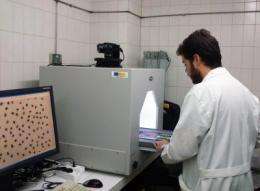A digital portrait for grapes indicates their ripeness

Researchers at the University of Seville (Spain) have developed a technique for estimating grape composition and variety using computer imaging. They have also put forward an index for identifying the ripeness of seeds without the need for chemical analysis. This new method can help to decide the best moment for picking.
The normal procedure for identifying the sugar content of grapes involves chemical analysis. But this is a long and tedious task that tells vine-growers when to start picking their grapes. Now though, scientists at the University of Seville (US) are proposing an alternative technique: photographing grapes and analysing the images.
The method consists of inserting the fruit or seeds into a light controlled cabin. Computer imaging then identifies exact colour in accordance with International Commission on Illumination standards along with morphological characteristics such as length, width and sphericity.
Lastly, using software developed by the researchers themselves, the variety of samples can be recognised by comparison with a pre-established database of images.
Published in the 'Computers and Electronics in Agriculture' journal, the study has been successfully validated in vineyards with the Denomination of Origin Condado de Huelva. The machine is capable of differentiating whether the grape is of the Tempranillo, Syrah or the native Zalema variety.
"The advantage of this technique is that it offers automated and speedy quality control and inspection as well as objective monitoring of the ripening process," as explained to SINC by Francisco J. Heredia, one of the authors and coordinator of the Food Colour and Quality Group of the US.
The researcher also highlights that they conceived a "browning index" for seeds – a parameter that estimates ripening stage regardless of variety and harvest year "solely using data provided by the images."
Revelation of phenolic content with images
In addition, thanks to statistical tools, the team has been able to confirm that there is indeed a direct relationship between the aspect and colour of seeds and their phenolic content, with phenols being compounds that determine the ripeness of the grape. This is also the case according to another study published in the 'Analytica Chimica Acta' journal, which obtained its results from La Rioja grapes collected on six separate occasions.
"The compounds analysed in the seeds are not the main causers of red wine colour, but their polymerisation and oxidation during the ripening phase cause browning in the seeds. This was determined using tristimulus colorimetry through digital imaging and is linked with composition," adds another of the authors, Francisco J. Rodríguez-Pulido.
Understanding this relationship "proves useful as a quick and objective estimation method when deciding upon the best time for picking and, therefore, the quality of the wine, without the need for chemical and sensory analyses."
Wine experts tend to use so-called 'technological ripening', based on sugar from juice, as a way of determining when to pick grapes. However, the authors have emphasised that the ripeness of seeds must not be forgotten as this also influences wine quality.
"In warm climates, like that enjoyed in the south of Spain, technological ripening occurs quickly and does not provide enough time for seeds protected inside the grape to develop at the same speed," explains Rodríguez-Pulido, who recognises the need for continued research so that in the future "grapes characteristics shown in their digital 'portrait' can be used to predict the type of wine that they will yield."
More information:
Francisco J. Rodríguez-Pulido, Luis Gómez-Robledo, Manuel Melgosa, Belén Gordillo,
M. Lourdes González-Miret, Francisco J. Heredia. "Ripeness estimation of grape berries and seeds by image analysis". Computers and Electronics in Agriculture 82: 128, 2012.
Francisco J. Rodríguez-Pulido, Raúl Ferrer-Gallego, M. Lourdes González-Miret, Julián Carlos Rivas-Gonzalo, María Teresa Escribano-Bailón, Francisco J. Heredia.
"Preliminary study to determine the phenolic maturity stage of grape seeds by computer vision". Analytica Chimica Acta 732: 78, 2012.


















